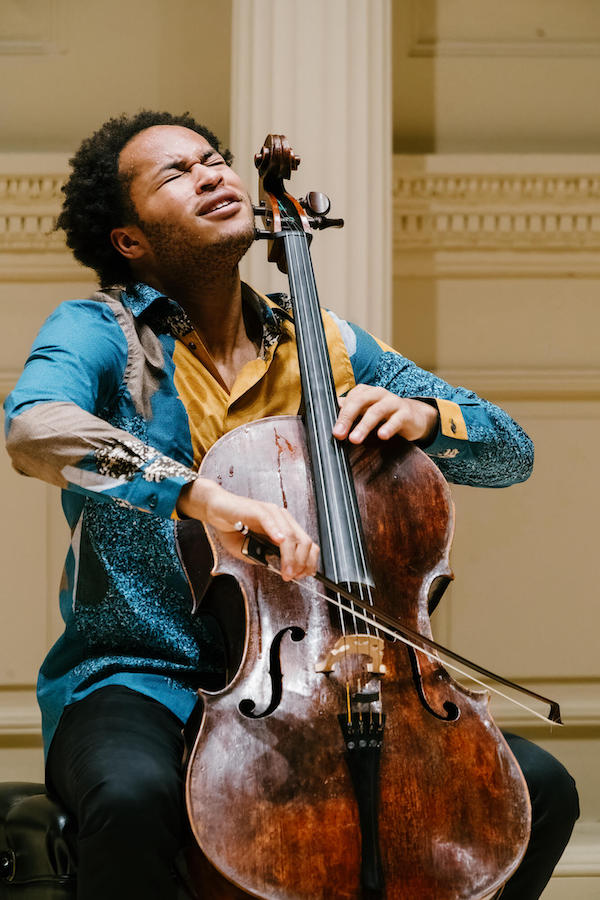Kanneh-Mason flies solo with illumination, individuality
A solo recital is a place for a performer to dig into their musical personality and present an extended monologue that covers their skills, their taste, and their willingness and confidence in baring their inner life for an audience.
Sheku Kanneh-Mason did just this Wednesday night in Weill Recital Hall. The young British cellist’s solo recital showed not just his considerable musicianship but was also a window into his musical thinking. The program had surprises in it that can’t be captured on albums—with their concessions to the market—or in performances with orchestras. Wednesday, that meant Bach, rarely heard 20th century works, and three recent commissions meant for the cellist.
The concert was also laid out in an idiosyncratic manner, with the most famous work (and arguably the best and grandest on the evening), Bach’s Cello Suite No. 2 in D, first, and the quirky placement of Gaspar Cassadó’s Cello Suite as the finale. That meant for some unevenness between the two halves and from piece to piece.
Kanneh-Mason has a wonderful sound that is big, throaty, and sinewy, and his intonation and articulation were excellent. The Prelude in the Bach suite hit from the opening moment with a feeling of energy and fullness that grabbed the listener.
This was beautiful, holistic playing, full of deep thinking about how the music should go. One heard this in the details of his phrasing, which seemed to come out of his body and was full of logical, elegant rubato, even as it was slightly off-kilter from what one usually hears. Kanneh-Mason integrated Bach’s arpeggiated harmonies, dance rhythms, and melodies into exacting balance. Puzzling as was the downbeat in the Courant, his focus on the lyrical movement of the melody was completely convincing.
He rounded off the first half with the New York premiere of Gwilym Simcock’s Prayer for the Senses and Benjamin Britten’s Cello Suite No. 1. Simcock’s work was one of the recent commissions, part of the Royal Academy of Music’s bicentennial celebration. Simock is a jazz pianist, and the music had all the strengths and flaws one often hears from jazz musicians writing for classical players; it was energetic and full of inventive moments, but never established a steady form and moved so capriciously from one idea to another that it never made much sense.
Britten’s Suite, a response to Bach, is a wonderful work that deserves more attention (like Britten in general). Like Bach, the music is both supremely intelligent and full of emotion, which in this case means an internal struggle between peace and anguish. It’s knife-edge expression, and Kanneh-Mason played it with power, a feeling of great weight in the “Canto” sections and a kind of tense, whistling-past-the-graveyard feeling in other sections.
The second half opened with the two other recent commissions: Leo Brouwer’s Sonata No. 2 for Solo Cello, and Five Preludes for Solo Cello by Edmund Finnis.
Brouwer is most well known for his guitar pieces, and the sonata showed his command of the cello as well. This was an intriguing, complex piece, somehow combining the earthiness and pastoralism of both Bartók and Vaughan Williams, while still sounding with an original voice. Kanneh-Mason’s involving playing was surely part of this, not just his technical command but the feeling that he understood Brouwer’s elusively captivating manner and wanted to impress that on the audience.
Finnis’ excellent Preludes were one of the high points of the recital, and a superb contrast with the meaty romanticism of Britten and Brouwer. They combined wonderful melodies and elegant harmonies, yet were concise with Finnis using the exact right amount of material, nothing more, nothing less. Kanneh-Mason’s beautiful sound showed that it only takes the simplest ideas to create great depth and complexity.
Cassadó’s Suite stood out as an oddity. Cassadó was a prominent cellist—a contemporary of Casals—and the piece is of course idiomatic for the instrument and also based on the rhythmic forms of Bach. It also seemed to be full of Cassadó’s ego, a work meant to show his self-regard as a musician, private in an anti-social way.
Kanneh-Mason gave it just as much personal attention as everything else, but could not quite overcome the subtle challenge of the music. It’s an extended showpiece, the kind of thing that would be ideal for an encore except it’s far too long for an encore. The notes sounded good, but the feeling was off.
After the extended encore sense of Cassado’s Suite, Kanneh-Mason acknowledged the standing ovation with a real encore, a succinct, delicate transcription of Bob Marley’s song “She Used to Call Me Dada,” played pizzicato. It felt like the most personal moment of the evening.
The Met Orchestra Chamber Ensemble plays Strauss, Santos Cota, Gabriella Lena Frank, and Copland, 7:30 p.m., Thursday, in Weill Recital Hall carnegiehall.org
